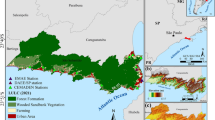Abstract
An integrated urbanization level (CL) index and an integrated natural disaster intensity (QC) index were developed on the basis of Disaster System Theory and China Natural Disaster Database for integrated urban disaster risk assessment. Integrated quantitative assessments of the urban socio-economic system and the intensity of hazards in China were carried out by the Model-Tupu (map series) and inter-feedback process using digital map technology. On the basis of this assessment, China can be regionalized into three regions, namely, coastal urban disaster region, eastern urban disaster region and western urban disaster region, 15 sub-regions and 22 units. These results can provide a scientific basis for determining a city’s disaster risk management and natural disaster relief regionalization in China.




Similar content being viewed by others
Notes
Urban light index is a man-made index representing the spatial distribution and intensity of nighttime lights based on DMSP/OLS data. It provides researchers with an image of lights from settlements at nighttime—as viewed from space. It is believed that the urban light index can be used to demonstrate urbanization level as, generally, large cities are always more densely and intensely lit up at night in comparison to less urbanized areas.
References
Blaikie P, Cannon T, Davis I, Wisner B (1994) At risk: natural hazards, people's vulnerability disasters. Routledge, London
Chung CF, Fabbri AG, Van Westen CJ (1995) Multivariate regression analysis for landslide hazard zonation. In: Carrara A, Guzzetti F (eds) Geographical information systems in assessing natural hazards. Kluwer, Dordrecht
Editor group of “Urban Development Report of China”, China Association of Mayors (2005) 2003–2004 Urban Development Report of China (in Chinese). Electronic Industry Press, Beijing
Fotheringham AS, Densham PJ, Curtis A (1995) The zone definition problem in location-allocation modeling. Locat Sci 3:64
Haining R (1990) Spatial data analysis in the social and environment sciences. Cambridge University Press, Cambridge
Ma ZJ (1994) China main natural disaster and relief disaster mitigation and prevention method (in Chinese). Science Press, Beijing
Rose WI, Bommer JJ, Sandoval C (2004) Natural hazards and risk mitigation in EI Salvador: An introduction. In: Rose WI, Bommer JJ, López DL, Carr MJ, Major JJ (eds) Natural hazards in EI Salvador: Boulder, Colorado. Geological Society of America Special Paper 375, 1–4
Shi L (2005) Urbanized ratio of China has entered a rapid increasing period (in Chinese). http://www.chinanews.com.cn/news/2005/2005-06-02/26/581726.shtml
Shi PJ (1991) The theory of disaster research and its practice (in Chinese). J Nanjing Univ (Natural Science) 11:37–42
Shi PJ (ed) (2003) Atlas of natural disaster system of China. Science Press, Beijing
Terlien MTJ, van Asch TWJ, Van Westen CJ (1995) Deterministic modeling in GIS-based landslide hazard assessment. In: Carrara A, Guzzetti F (eds) Geographical information systems in assessing natural hazards. Kluwer
Wang JA, Wang J, Ye T (2004) Hazard assessment of urban flood disaster and sustainable development in China (in Chinese). J Beijing Normal Univ (Social Science) 3: 138–143
Wang P, Shi PJ (2000) Comprehensive regionalization of agricultural natural disaster in China (in Chinese). J Nat Disasters 9:16–23
Wells G (1996) Hazard identification and risk assessment. Institution of Chemical Engineers, Warwickshire, UK
Xu W, Wang JA, Shi PJ (2004) Hazard degree assessment of urban earthquake disaster in China (in Chinese). J Nat Disaster 13:9–15
Zhang LS, Shi PJ, Wang JA (1995) Regionalization of natural disasters in China (in Chinese). J Beijing Normal Univ (Natural Science) 31:415–421
Zhang PY, Wang FH, Jiang H (1992) The geographical distribution regular and region relief disaster of main natural disaster in China. In: Geography Department of Chinese Academy of Science (ed) China natural disaster hazard analysis and disaster relief (in Chinese). Hubei Science Technology Press, Wu Han
Zhuo L, Shi PJ, Chen J (2003) Application of Compound Night Light Index derived from DMSP/OLS data to urbanized analysis in China in the 1990s (in Chinese). Acta Geogr Sin 58:901–902
Acknowledgements
This paper was financially supported by the National Natural Science Foundation of China (NSFC) General Project Study on Assessment Method of Post-disaster Resilience of Regional Agricultural Drought and Integrated Disaster Reduction Mechanism (Project No.40671003), NSFC International Cooperation Project Study on Flood Integrated Risk Assessment Model and Flood Reduction Strategy in Dongting Lake Region of China (Project No.40535024). We gratefully acknowledge the thoughtful comments of the editor and reviewers.
Author information
Authors and Affiliations
Corresponding author
Rights and permissions
About this article
Cite this article
Wang, Ja., Shi, Pj., Yi, Xs. et al. The regionalization of urban natural disasters in China. Nat Hazards 44, 169–179 (2008). https://doi.org/10.1007/s11069-006-9102-1
Received:
Accepted:
Published:
Issue Date:
DOI: https://doi.org/10.1007/s11069-006-9102-1




